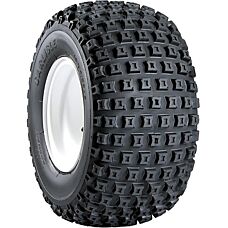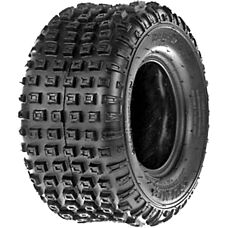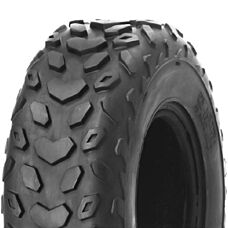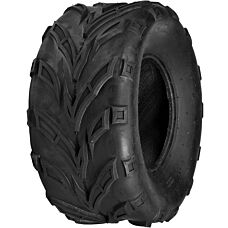-
 MSRP $44.75 per tire $36.99Low Stock (8)Enter your zip code for delivery timesShow tire specifications Hide tire specifications
MSRP $44.75 per tire $36.99Low Stock (8)Enter your zip code for delivery timesShow tire specifications Hide tire specificationsSKU N982500-99 Type ATV & UTV Road Hazard Warranty No Load Range 2 Ply Speed Rating N/A Performance All Terrain MPN WD1042 Overall Diameter 14 Season All Season Aspect Ratio 70 Brand Hi-Run UTQG N/A Run Flat No Rebate Available No Country of Origin N/A Sidewall BSW: Black Side Wall Size 145/70-6 Load Index 18 Section Width 145 Model SU13 Rim Diameter 6 -
 MSRP $51.75 per tire $44.99In Stock (10+)Enter your zip code for delivery timesShow tire specifications Hide tire specifications
MSRP $51.75 per tire $44.99In Stock (10+)Enter your zip code for delivery timesShow tire specifications Hide tire specificationsSKU N974146-99 Type ATV & UTV Road Hazard Warranty No Load Range 2 Ply Speed Rating N/A Performance All Terrain MPN 30105002 Overall Diameter 14 Season All Season Aspect Ratio 70 Brand Nanco UTQG N/A Run Flat No Rebate Available No Country of Origin N/A Sidewall BSW: Black Side Wall Size 145/70-6 Load Index 10 Section Width 145 Model N688 Rim Diameter 6 -
 MSRP $45.75 per tire $37.99In Stock (10+)Enter your zip code for delivery timesShow tire specifications Hide tire specifications
MSRP $45.75 per tire $37.99In Stock (10+)Enter your zip code for delivery timesShow tire specifications Hide tire specificationsSKU N1517785-99 Type ATV & UTV Road Hazard Warranty No Load Range 2 Ply Speed Rating F Performance All Terrain MPN P333WD1 Overall Diameter 14 Season All Season Aspect Ratio 70 Brand Wanda UTQG N/A Run Flat No Rebate Available No Country of Origin N/A Sidewall BSW: Black Side Wall Size 145/70-6 Load Index 18 Section Width 145 Model P333 Rim Diameter 6 -
 Carlisle (Carlstar) Knobby 145/70-6 1-Star AT A/T All Terrain Tire
Carlisle (Carlstar) Knobby 145/70-6 1-Star AT A/T All Terrain Tire 145/70-6
145/70-6 All Season
All Season
 All Terrain
Low Stock (8)MSRP $59.75 per tire $51.99Low Stock (8)Enter your zip code for delivery timesShow tire specifications Hide tire specifications
All Terrain
Low Stock (8)MSRP $59.75 per tire $51.99Low Stock (8)Enter your zip code for delivery timesShow tire specifications Hide tire specificationsSKU N895243-99 Type ATV & UTV Road Hazard Warranty No Load Range 1-Star Speed Rating N/A Performance All Terrain MPN 5150021 Overall Diameter 14.3 Season All Season Aspect Ratio 70 Brand Carlisle UTQG N/A Run Flat No Rebate Available No Country of Origin N/A Sidewall BSW: Black Side Wall Size 145/70-6 Load Index N/A Section Width 145 Model Knobby Rim Diameter 6 -
 MSRP $47.75 per tire $41.99In Stock (10+)Enter your zip code for delivery timesShow tire specifications Hide tire specifications
MSRP $47.75 per tire $41.99In Stock (10+)Enter your zip code for delivery timesShow tire specifications Hide tire specificationsSKU N895244-99 Type ATV & UTV Road Hazard Warranty No Load Range 2 Ply Speed Rating N/A Performance All Terrain MPN 1457068009-2 Overall Diameter 14.3 Season All Season Aspect Ratio 70 Brand Innova UTQG N/A Run Flat No Rebate Available No Country of Origin N/A Sidewall BSW: Black Side Wall Size 145/70-6 Load Index 18 Section Width 145 Model Knobby Gear Rim Diameter 6 -
 MSRP $39.75 per tire $32.68In Stock (10+)Enter your zip code for delivery timesShow tire specifications Hide tire specifications
MSRP $39.75 per tire $32.68In Stock (10+)Enter your zip code for delivery timesShow tire specifications Hide tire specificationsSKU N1667293-99 Type ATV & UTV Road Hazard Warranty No Load Range 2-Star Speed Rating N/A Performance All Terrain MPN W3191457062 Overall Diameter 14 Season All Season Aspect Ratio 70 Brand Journey UTQG N/A Run Flat No Rebate Available No Country of Origin N/A Sidewall BSW: Black Side Wall Size 145/70-6 Load Index 19 Section Width 145 Model W319 Rim Diameter 6 -
 MSRP $34.75 per tire $29.99In Stock (10+)Enter your zip code for delivery timesShow tire specifications Hide tire specifications
MSRP $34.75 per tire $29.99In Stock (10+)Enter your zip code for delivery timesShow tire specifications Hide tire specificationsSKU N1667303-99 Type ATV & UTV Road Hazard Warranty No Load Range 2 Ply Speed Rating N/A Performance All Terrain MPN W3301457062 Overall Diameter 14 Season All Season Aspect Ratio 70 Brand Journey UTQG N/A Run Flat No Rebate Available No Country of Origin N/A Sidewall BSW: Black Side Wall Size 145/70-6 Load Index 19 Section Width 145 Model W330 Rim Diameter 6 -
 MSRP $43.75 per tire $35.99Low Stock (8)Enter your zip code for delivery timesShow tire specifications Hide tire specifications
MSRP $43.75 per tire $35.99Low Stock (8)Enter your zip code for delivery timesShow tire specifications Hide tire specificationsSKU N1025840-99 Type ATV & UTV Road Hazard Warranty No Load Range 2 Ply Speed Rating N/A Performance All Terrain MPN 94000647 Overall Diameter 14.4 Season All Season Aspect Ratio 70 Brand BKT UTQG N/A Run Flat No Rebate Available No Country of Origin N/A Sidewall BSW: Black Side Wall Size 145/70-6 Load Index N/A Section Width 145 Model AT-109 Rim Diameter 6 -
 MSRP $43.75 per tire $35.99In Stock (10+)Enter your zip code for delivery timesShow tire specifications Hide tire specifications
MSRP $43.75 per tire $35.99In Stock (10+)Enter your zip code for delivery timesShow tire specifications Hide tire specificationsSKU N1685988-99 Type ATV & UTV Road Hazard Warranty No Load Range 4 Ply Speed Rating N/A Performance All Terrain MPN QD116145706 Overall Diameter 14 Season All Season Aspect Ratio 70 Brand Qind UTQG N/A Run Flat No Rebate Available No Country of Origin N/A Sidewall BSW: Black Side Wall Size 145/70-6 Load Index N/A Section Width 145 Model QD-116 Rim Diameter 6
145/70-6 Tires
145/70-6 Tire Size Explanation
- 145 - This number represents the tire’s width in millimeters, measured from one shoulder to the other. In this case, the tire’s width is 145 mm (5.71 inches).
- 70 - The aspect ratio is expressed as a percentage of the tire’s height to its width. A 70-aspect ratio means that the tire’s height is 70% of its width (in this case it is 101.5 mm / 4 inches).
- - - This indicates that the tire was manufactured with a bias construction, which is designed for larger load durability.
- 6 - This last number denotes the diameter of the wheel in inches. This tire was manufactured to be mounted on 6-inch (152.4 mm) wheels.
Factors to Consider When Choosing 145/70-6 Tires:
Apart from the tire size, drivers must consider multiple other factors as well, before deciding which tires to purchase. Here are some things to look into:
Vehicle Compatibility:
While the 145/70-6 tires might be what you want, it depends on your vehicle’s needs. Check the recommended tire size before purchasing.
Tire Type:
After deciding on the tire size, figure out whether you need snow tires or all season tires (maybe even summer tires) for your specific application.
Tread Pattern:
The optimized tread pattern of 145/70-6 tires helps improve the vehicle’s performance and driving safety.
Budget:
Create a budget! 145/70-6 tires can be pricey and creating a budget range will help you decide between different tires more easily.
Brand and Quality:
Research the tires you are interested in before finalizing your purchase. Get the quality tires that work best for your vehicle.
Load and Speed Rating:
Matching load ranges, load indexes, and speed ratings to the vehicle’s needs is crucial to ensure a secure performance.
Tire Maintenance
Proper tire maintenance is crucial to ensure the tire’s lengthened usability. This helps protect the tires from tread and external damage.
Conclusion:
For a popular but diverse fit, 145/70-6 tires are ideal. They can be used on various vehicles, depending on their load and speed ranges. Yet, 145/70-6 tires are still able to offer the necessary traction, handling, and durability in different applications. Make sure these tires are the right fit for your vehicle’s needs, driving habits, and weather or road conditions, and they will serve you for a long time.









Login and Registration Form